SAP Business One In-Depth Review: Item Master Data
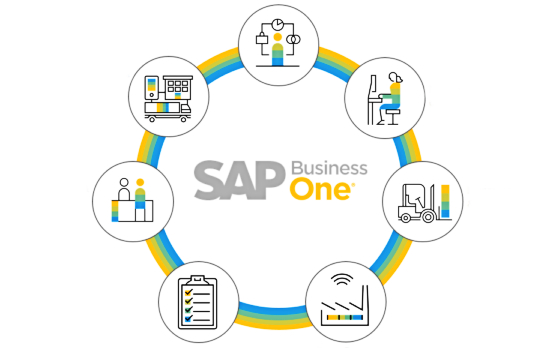
Today, we continue our SAP Business One tutorial exploring a very important topic – item master data. This material aims to describe the core principles associated with the entity as well as explain the sections and fields of the SAP Business One item master data screen. Let’s take a look at what’s hidden under the hood of the popular ERP system.

Table of contents
SAP Business One Item Master Data Basics
At first glimpse, you may spot that item master data entirely differs from business partner master data. Although they carry content with little to zero similarities, you set up both screens in the same way. If you are familiar with one process, another one won’t bring any difficulties.
The main purpose of SAP B1 item master data records is to keep track of products you sell, purchase, and keep in the inventory. Thus, item master data is the foundation of almost every process in the ERP system. The corresponding information is utilized by almost every module. Thus, SAP B1 item master data is a vital part of the routine associated with the following tools:
- Sales module;
- Purchasing module;
- Production module;
- MRP module;
- Inventory module;
- Service module.
SAP Business One Item Master Data Screen
Now, when you know what SAP B1 master data is and how important it is, we’d like to draw your attention to different practical aspects associated with the entity. Below, we describe the SAP Business One item master data screen. Just like the corresponding window with business partner information, it is divided into two parts: a header and numerous tabs below.
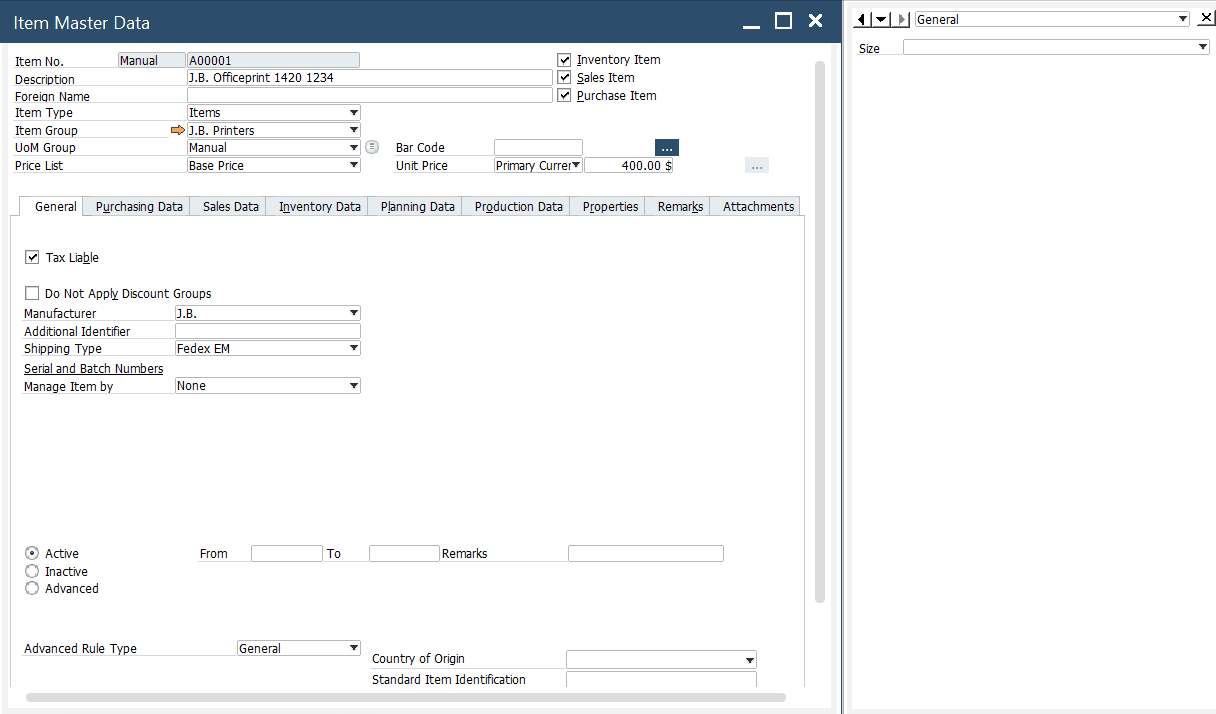
Header
You can find and edit summary information that describes the item in the header section, while each tab delivers additional details about various item aspects.

The SAP B1 item master data record header contains a unique ID number associated with a product. You can assign it manually or configure automated assignment via a numbering series. Besides, there is a short item description in two languages. Numerous header settings help to determine the item type, UoM (units of measure), its group, main price list, as well as applicable price.
Checkboxes on the right help you determine whether to keep the item in inventory, provide it for sale, make it available for purchase. At the same time, SAP Business One lets you mark the item as a fixed asset.
General tab
Now, let’s look at the General tab of the SAP B1 item master data screen. The window is filled with information about the manufacturer, various identifiers, associated shipping methods, and related issue methods.
You can make the item tax liable and disable the application of discount groups. It is also possible to activate/deactivate the product for a particular period. Such fields as Country of Origin, Standard Item Identification, and Commodity Classification are at your service too.
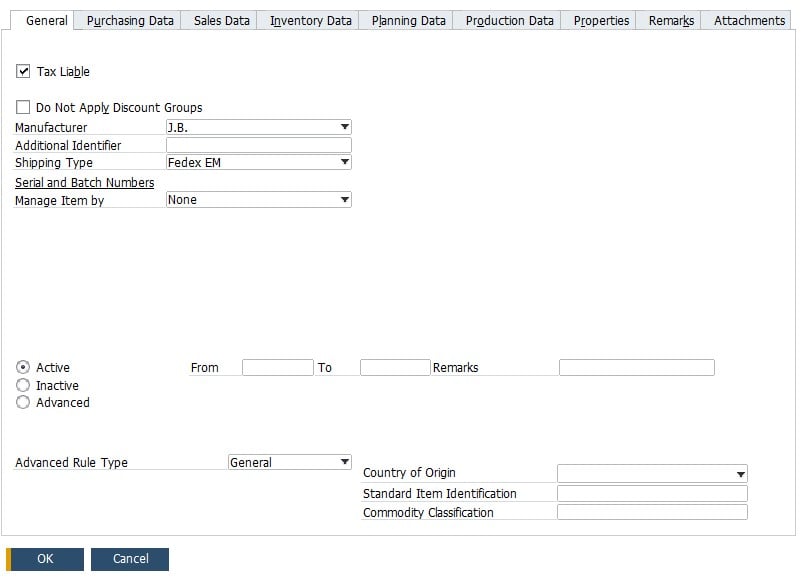
Purchasing Data tab
Under the Purchasing Data tab, you will discover the main item seller. Besides, the section provides information on how to identify the item in a catalog, what measurement units are used for purchasing, as well as actual item sizes. You can select a customer group and tax exempt here.
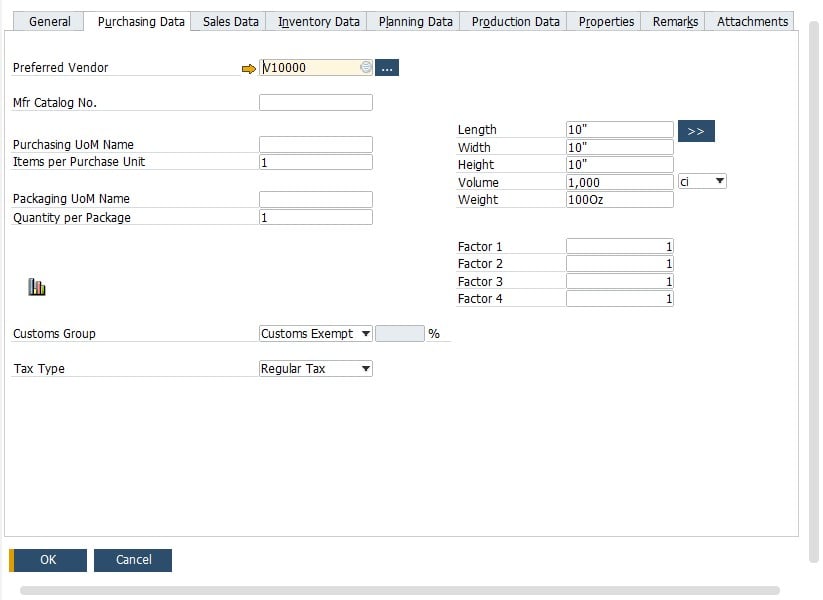
If it is not a newly added item, it may have a purchasing history. In this case, you can display a graphical purchase analysis. Hit the chart icon on the lower left of the tab.
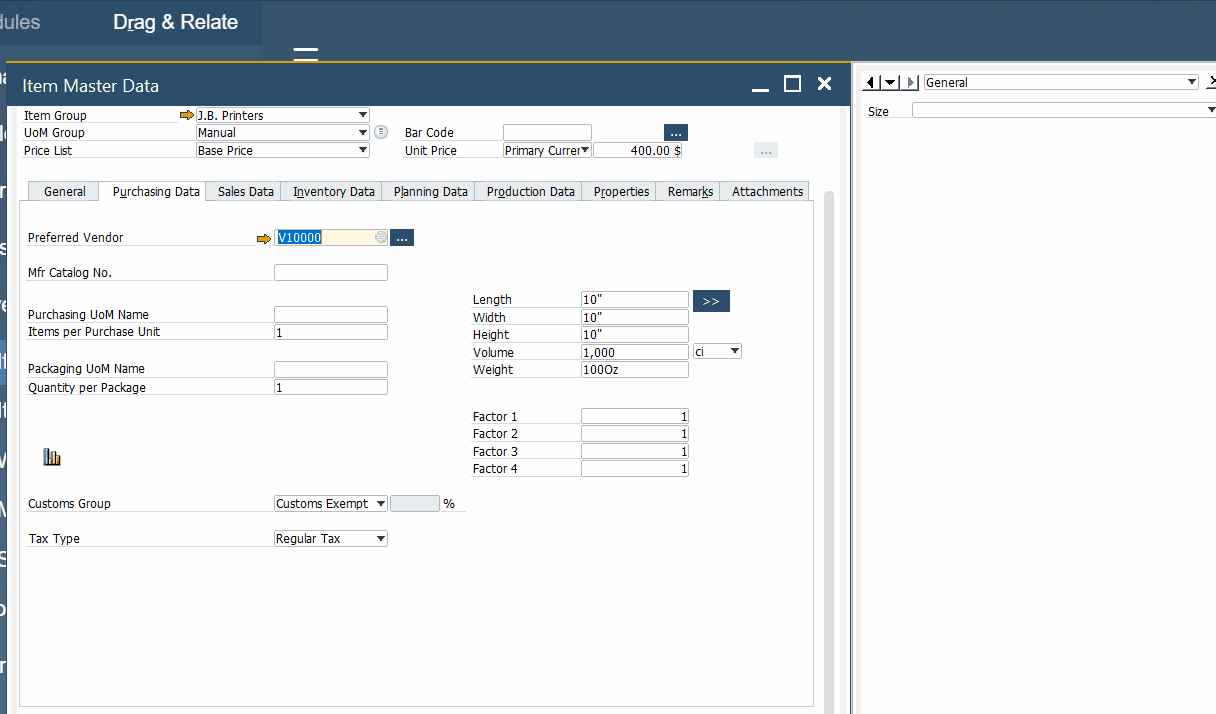
Sales Data tab
The Sales Data tab is similar to the Purchasing Data tab. It contains various parameters necessary to determine how to handle the item, including measurement units and packaging. Besides, the tab provides a graphical view of the related sales data. Hit the chart icon on the lower left to see the diagram.
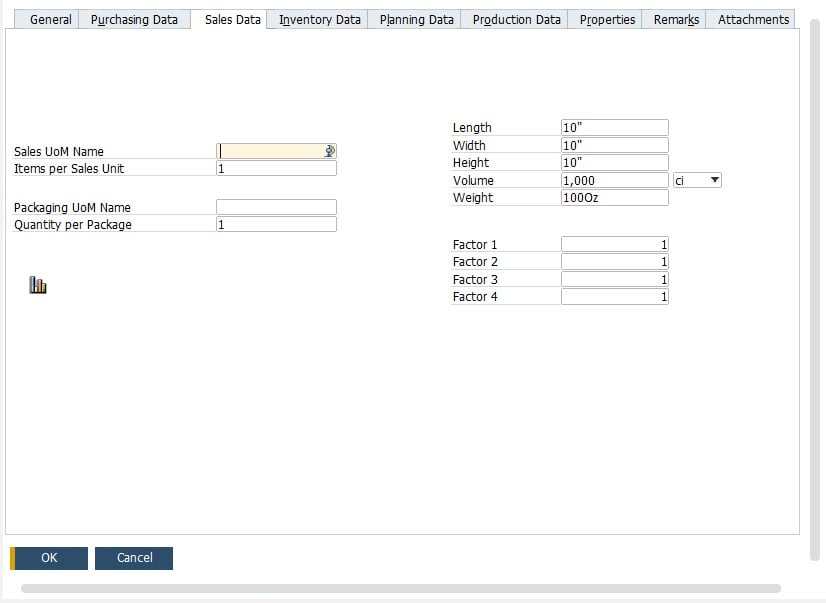
Inventory Data tab
Due to the Inventory Data tab of the SAP Business One item master data window, you can keep track of warehouses’ quantities. Besides, it allows you to set various management parameters:
- A valuation method. It calculates item costs for the perpetual inventory system. The default value is based on the selected item group. When you set up the item for the first time, SAP Business One lets you choose one of the following valuation methods: Standard, Moving Average, FIFO, or Serial/Batch.
- The Manage Inventory by Warehouse checkbox. It determines how to manage item quantities: separately per warehouse or company level. Check the box to transfer the Maximum, Minimum, and Required quantity fields to the warehouse grid.
- The actual inventory quantities. Here, you can specify how many items are available in a separate warehouse.
Note that we focus on the perpetual inventory system of SAP Business One in the corresponding articles.
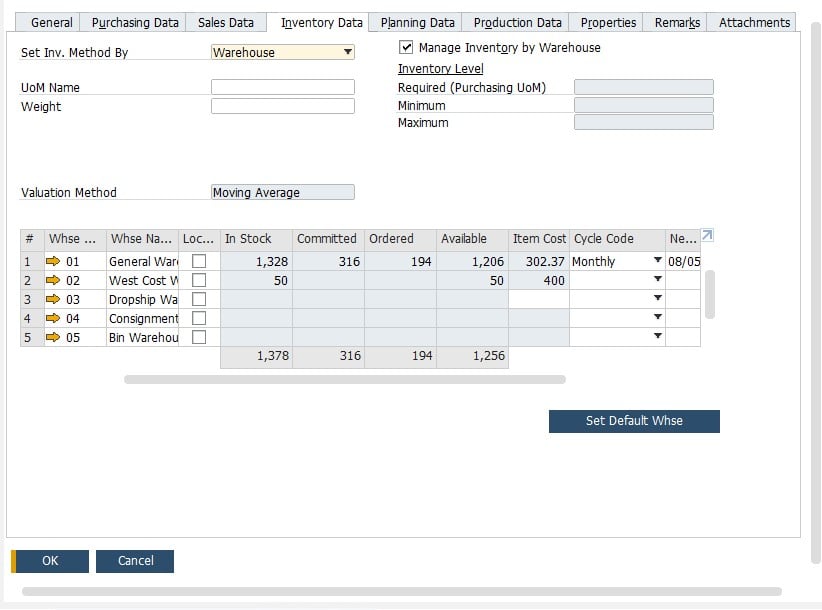
You can see that item is available in the two first warehouses with 1,328 and 50 items per each correspondingly on the image below. Item cost per warehouse and ordered quantity are also displayed in the grid.
Planning Data tab
The Planning Data tab of the SAP Business One item master data screen determines how the planning for purchasing and production takes place. The ERP system lets you configure such parameters as the order interval, order multiple, and minimum order quantity. Besides, you can specify the required lead and tolerance time in days. The MRP module uses these fields to simplify various routine processes associated with the product planning.
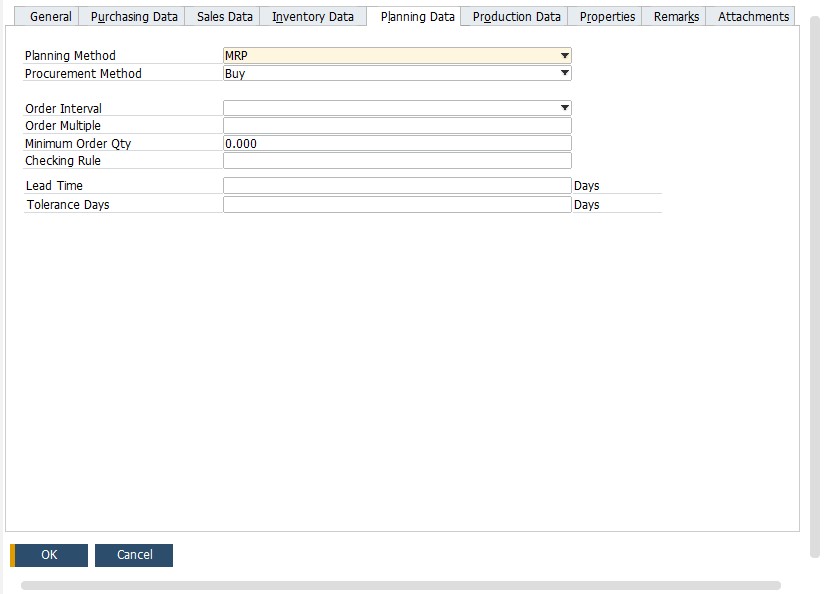
Production data
Under this tab of the SAP B1 item master data, you can specify whether you deal with a phantom item. Besides, it is possible to choose an issue method. Other fields let you provide a BOM type and the number of item components, resource components, and route stages. You can even set up the production cost here.
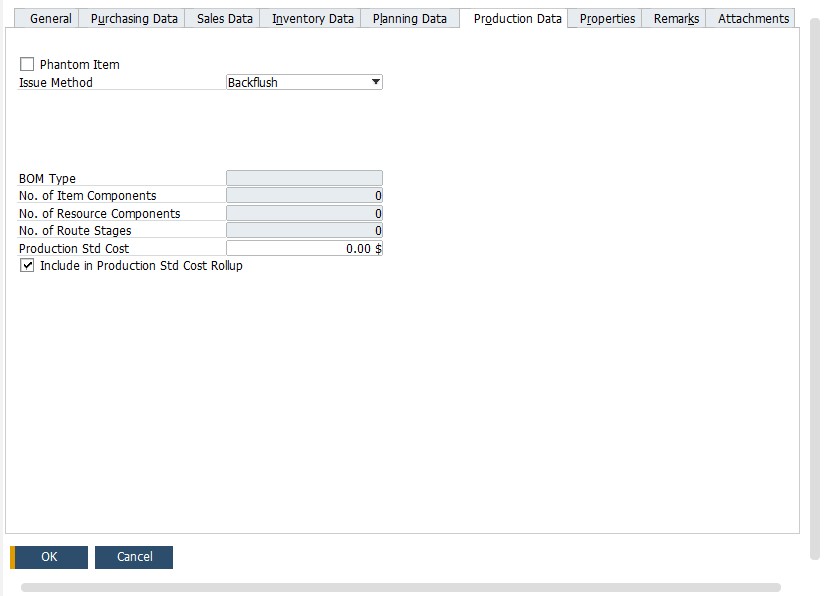
Properties tab
Various item properties are listed here.
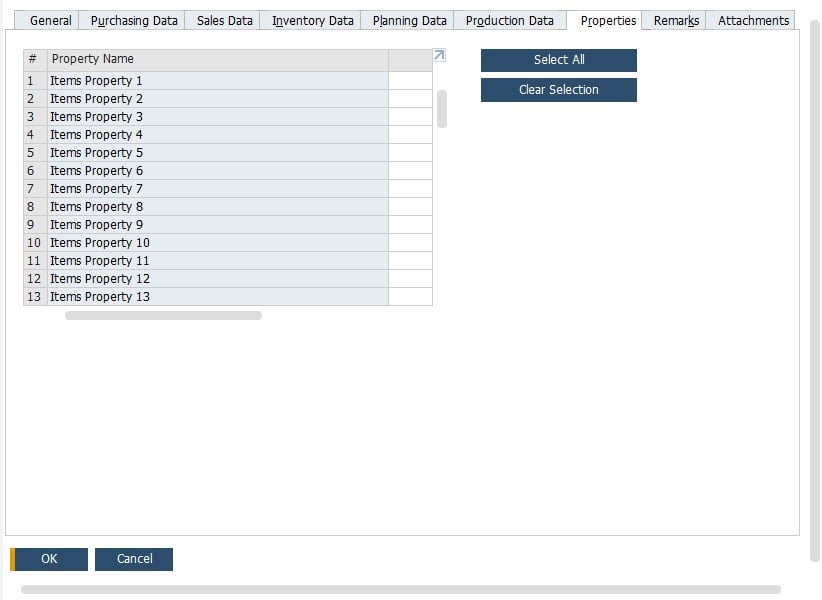
Remarks tab
You can leave any remarks associated with the item under this tab.
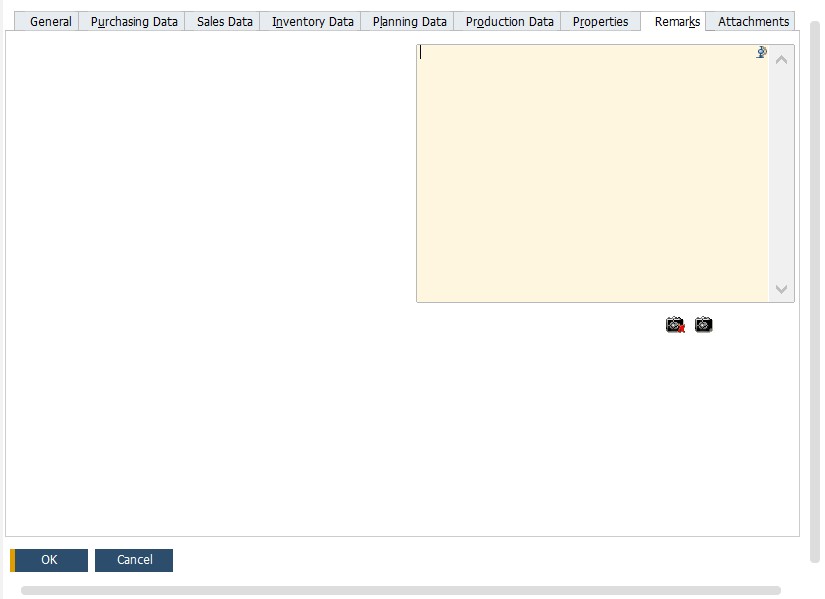
Attachments tab
Various attached files associated with an item master data record can be stored here.
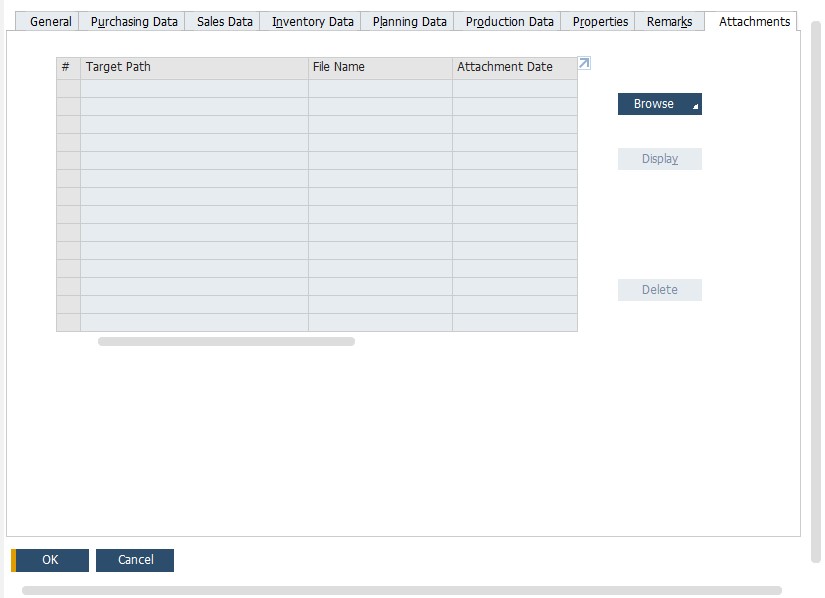
SAP Business One Units of Measure
Since we are talking about the SAP B1 item master data, it is also worth mentioning units of measure the system uses to let you sell items in all possible shapes and sizes. Thus, the ERP platform enables you to purchase and sell items in different packages. To achieve this goal, SAP Business One lets you define Unit of Measure groups. They illustrate the ratio between different measures so that the system can automatically convert units of measure between each other.
You can find two setup windows for defining units of measure in SAP Business One. They are situated under Administration/Setup/Inventory. The Units of Measure window lets you define all the possible units, including volume and weight.

Next, you have to configure Units of Measure Groups. The list of groups looks as follows:

The system lets you specify the base unit and its ratio to other units of measure, like illustrated on the image below:

As we’ve already mentioned, the item master data screen in SAP Business One lets you assign the group and set up a default unit of measure via purchasing, sales, and inventory tabs. Note that the data specified in each tab may be different.
Note that creating sales and purchasing documents is associated with the default unit of measure. Although it is populated automatically, The ERP system allows for replacing it if necessary. However, inventory and production documents are associated with the base units only.
Selling items by weight in SAPB1 is associated with the weight factor. You can leverage it at the stage of creating the units of measure groups. Suppose you purchase a box of items but sell them by kilos or pounds. In that case, the system lets you create a UoM for kilos and pounds and leverage the additional column in the unit of measure group window to incorporate a weight factor. Next, SAP Business One will use the company’s weight setup to convert the base unit into the appropriate unit in the document. Besides, it is possible to utilize any custom field from the item as a factor for the unit conversion.
The system lets you avoid defining units of measure groups. Instead, you can use the Manual UoM group for your items, creating a relationship between a base unit and a different quantity for receiving or selling items.
To enable this feature, you have to:
- Open the Sales Data and Purchasing Data tabs of the item master data record you want to edit.
- Set the Items per Purchase/Sales unit.
Note that the system multiplies the quantity entered here by the quantity specified in the document. Thus, the total quantity of the inventory change is calculated. For instance, a case of 6 bottles is added to the stock as 6 bottles instead of a single case.
The good news is that SAP B1 lets you update this field in the item master or the document itself. This extra flexibility allows for reflecting different units of measure for a single item.
How to sync SAP B1 Item Master Data With External Systems
SAP Business One delivers tools for integrating with external systems out of the box. However, they are not enough to transfer products and all the related data from external systems to new item master data records. Therefore, third-party tools are mandatory for achieving this goal. For instance, you can synchronize SAP Business One item master data records between Magento 2 and the ERP system with the Improved Import & Export extension and its addon. Peruse this blog post for more information: How to Synchronize Products in Magento 2 SAP Business One Integration. Besides, we offer a similar connector for Shopify.
Contact us to get more information on how to move SAP B1 item master data records between the ERP platform and any external system. Our team will help you integrate SAP Business One with your business.
Also, check our SAP Business One Integration solution for Magento 2:









